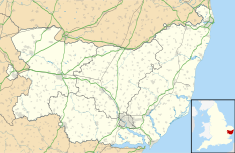Southwold Town Hall is a municipal building in the Market Place in Southwold, Suffolk, England. The building, which is the meeting place of Southwold Town Council, is a Grade II listed building.[1]
| Southwold Town Hall | |
|---|---|
 Southwold Town Hall | |
| Location | Market Place, Southwold |
| Coordinates | 52°19′34″N 1°40′45″E / 52.3262°N 1.6793°E |
| Built | 1810 |
| Architectural style(s) | Georgian style |
Listed Building – Grade II | |
| Official name | Town Hall |
| Designated | 21 April 1949 |
| Reference no. | 1384392 |
History
editThe first municipal building in the town was an ancient guildhall which was destroyed in the great fire which engulfed the town in April 1659.[2][3] A second town hall was built shortly after the Battle of Solebay in June 1672. It was a single-storey rectangular building on Bartholomew Green with a cottage attached. The historian, Agnes Strickland, speculated that it may have been built as a hospital for the wounded from the battle.[4] After the earlier building had been demolished in 1816,[5] a third town hall, which was also used as a school, was built to the east of St Edmund's Church and was completed in around 1817.[6][7][8]
The current town hall was commissioned by a hotelier, Thomas Bokenham, as a private house in around 1810.[9] Bokenham acquired the Swan Hotel, adjacent to his house, in 1819.[10] He died in about 1846 and his wife, Elizabeth, was in ill-health by the mid-1850s.[10] The building was acquired by the borough council and, by the late 19th century, was operating as a town hall.[11]
The design involved a symmetrical main frontage with three bays facing onto the Market Place; in the left hand bay, there was a doorway with a rectangular fanlight flanked by pilasters supporting an entablature and a modillioned cornice. The other two bays on the ground floor formed an opening for the horse-drawn fire engine, while the bays on the first and second floors were fenestrated with sash windows. On the first floor, there was a cast iron balcony which stretched the full width of the building. Internally, the principal room was the council chamber on the first floor.[1]
The building continued to serve as the headquarters of the borough council for much of the 20th century,[12] but ceased to be the local seat of government when the enlarged Waveney District Council was formed in 1974.[13] Instead it became the meeting place of Southwold Town Council.[14]
References
edit- ^ a b Historic England. "Town Hall (1384392)". National Heritage List for England. Retrieved 20 April 2022.
- ^ Nall, John Greaves (1866). Great Yarmouth and Lowestoff, a handbook for visitors and residents. Longmans. p. 223.
- ^ "Southwold Conservation Area Character Appraisal" (PDF). Waveney District Council. p. 9. Retrieved 19 March 2023.
- ^ "Southwold". Pall Mall Magazine. 1893. p. 250. Retrieved 20 April 2022.
- ^ "Bartholomew Green". Southwold and Son. Retrieved 20 April 2022.
- ^ An interesting history and topographical description of Southwold and its vicinity. Halesworth: W. Harper. 1817. p. 11.
- ^ Lewis, Samuel (1848). "'Southwick - Soyland', in A Topographical Dictionary of England". London: British History Online. pp. 152–156. Retrieved 20 April 2022.
- ^ Wake, Robert (1839). Southwold and Its Vicinity, Ancient and Modern. F. Skill. p. 257.
- ^ "Southwold Conservation Area Character Appraisal with Management Plan" (PDF). East Suffolk Council. p. 28. Retrieved 20 April 2022.
- ^ a b "No 6 Market Place - (The Swan Hotel)". Southwold and Son. Retrieved 20 April 2022.
- ^ Lane, John (1895). "Masonic records, 1717-1894". Dalcassian Publishing Company. p. 291.
- ^ "No. 44824". The London Gazette. 10 April 1969. p. 3775.
- ^ Local Government Act 1972. 1972 c.70. The Stationery Office Ltd. 1997. ISBN 0-10-547072-4.
- ^ "Welcome". Southwold Town Council. Retrieved 20 April 2022.
